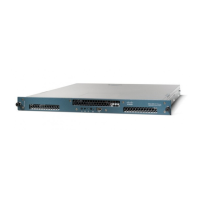7-19
Cisco 4700 Series Application Control Engine Appliance Administration Guide
OL-11157-01
Chapter 7 Configuring Redundant ACE Appliances
Configuring Redundancy
Configuring an FT Group
On each ACE, you can create multiple FT groups, up to a maximum of 21 groups
(20 user contexts and 1 Admin context). Each group consists of a maximum of two
members (contexts): one active context on one appliance and one standby context
on the peer appliance.
To create an FT group, use the f
t group command in configuration mode. You
must configure the same group ID on both peer appliances. The syntax of this
command is:
ft group g
roup_id
The g
roup_id argument specifies a unique identifier of the group. Enter an integer
from 1 to 20.
For example, enter:
host1/Admin(config)# ft group 1
host1/Admin(config-ft-group)#
To remove the group from the configuration, enter:
host1/Admin(config)# no ft group 1
After you create an FT group, configure the FT group attributes as described in
the following topics:
• Associating a Context with an FT Group
• Associating a Peer with an FT Group
• Assigning a Priority to the Active FT Group Member
• Configuring Preemption
• Placing an FT Group in Service
Associating a Context with an FT Group
An FT group consists of two members (contexts) with the same name, each
residing on a different ACE. To associate a context with an FT group, use the
associate-context command in FT group configuration mode. You need to make
this association for both redundant contexts in an FT group. The syntax of this
command is:
associate-context na
me

